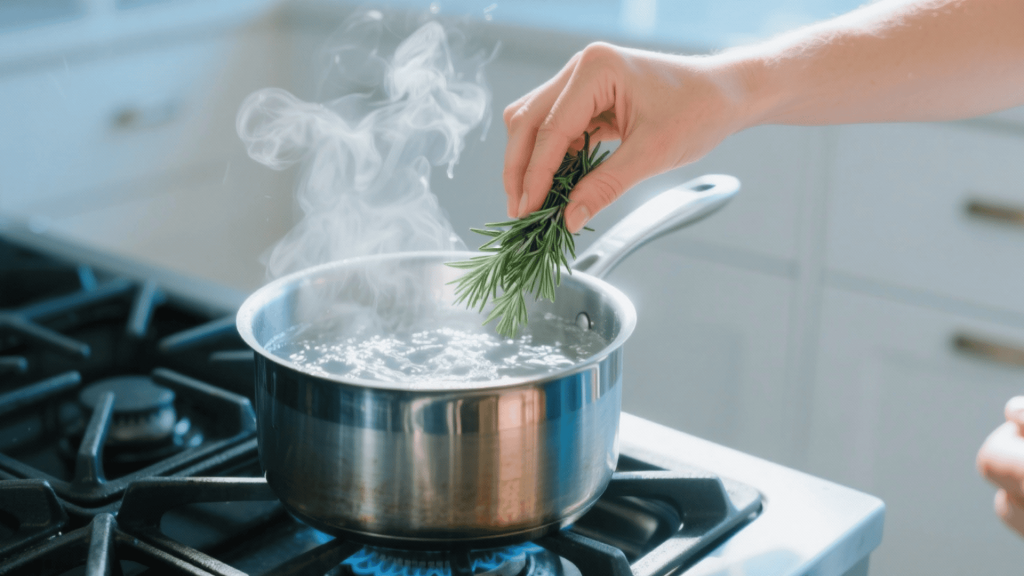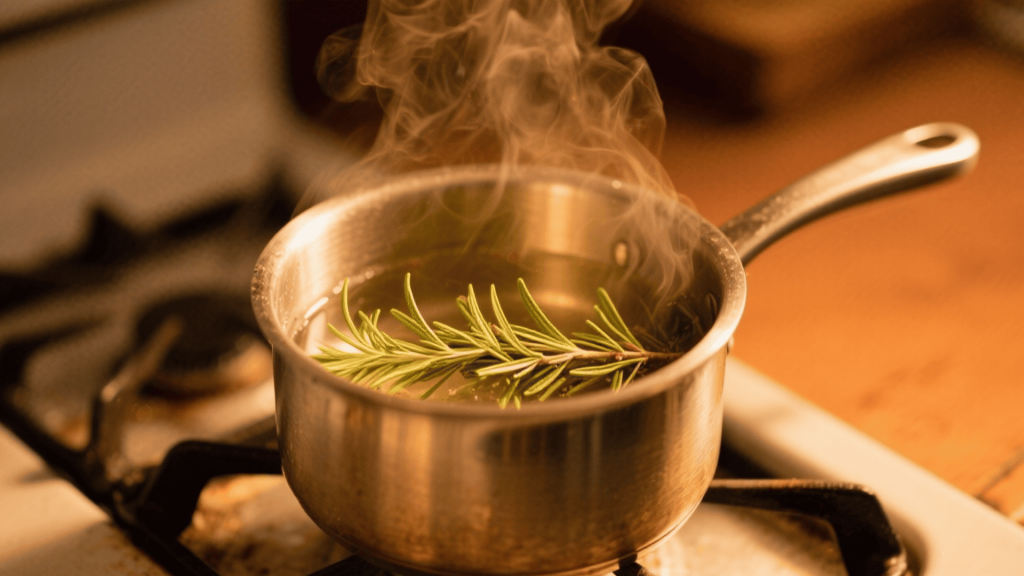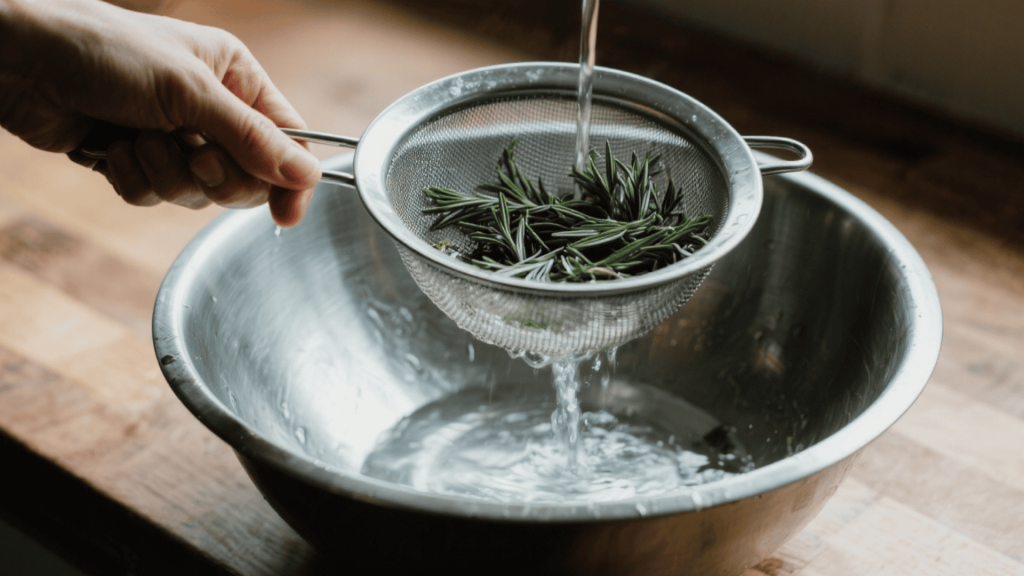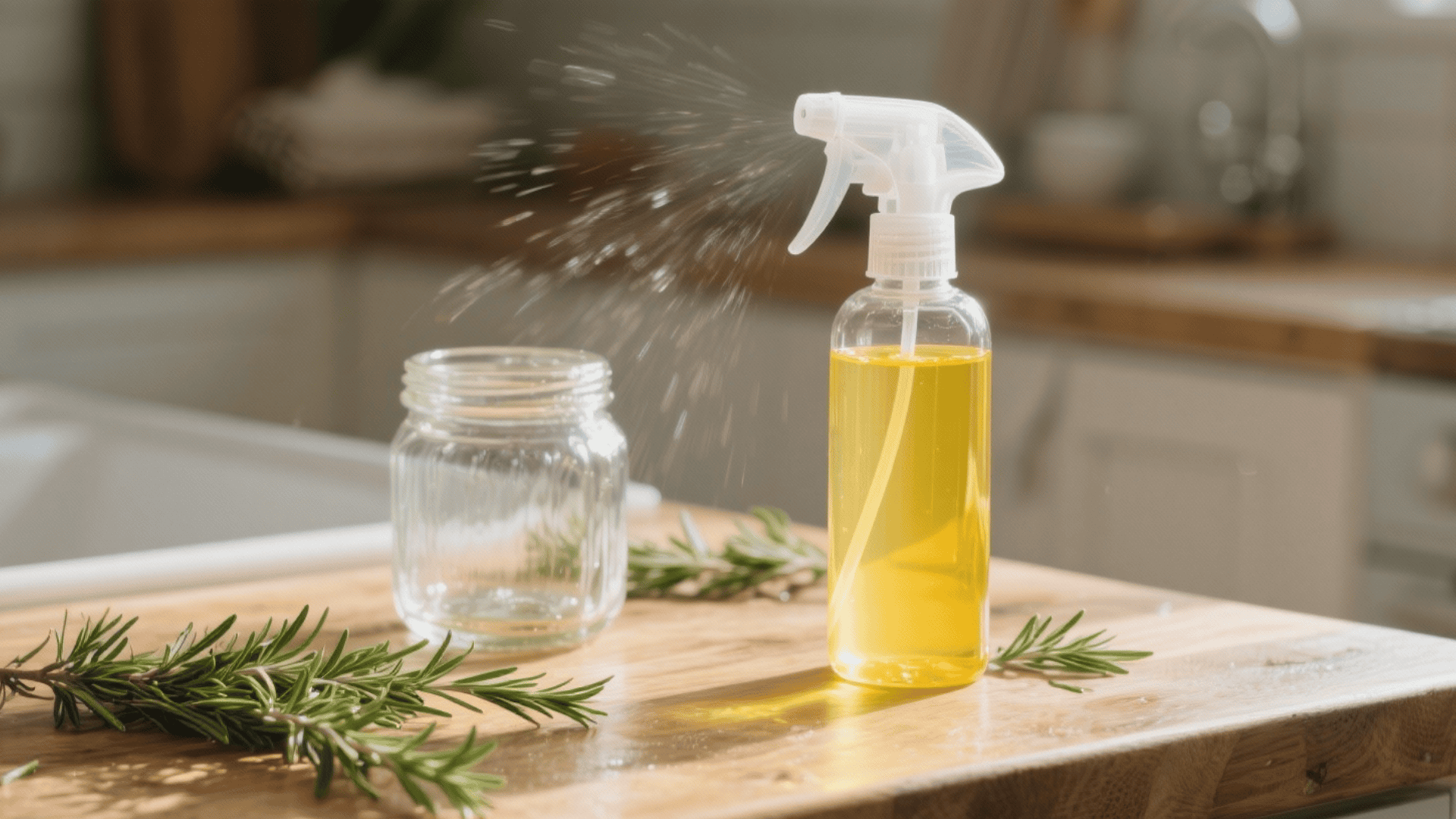I’ve been hearing a lot about rosemary water for hair lately, and I was curious to know if it actually works. After dealing with slow hair growth and thinning spots, I decided to try making my own rosemary water at home.
The internet is full of people sharing amazing before-and-after photos, claiming that this simple herb water changed their hair.
But does it really live up to the hype? I’m here to share everything I’ve learned about making rosemary water for hair, along with my honest experience using it.
Let me walk you through the process and tell you what actually happened when I tried it.
What is Rosemary Water for Hair?
Learning how to make rosemary water for hair is simple, just steep rosemary leaves in hot water like making regular tea, but use it as a hair treatment instead of drinking it.
People have used rosemary for hair care for centuries, with ancient cultures rinsing hair with rosemary-infused water for health and shine.
Today, this traditional remedy is making a comeback as modern hair enthusiasts discover how to make rosemary water for hair using just two natural ingredients.
Many prefer this budget-friendly, gentle option over costly synthetic products that often promise much but deliver few results.
Benefits of Rosemary Water for Hair
People turn to learning how to make rosemary water for hair because it offers several promising benefits for hair health.
Here’s what research and user experiences suggest about how to make rosemary water for hair and what it can do:
- Stimulates hair growth: Rosemary contains compounds that may improve blood circulation to the scalp, potentially encouraging new hair growth over time
- Reduces hair loss: Some studies suggest rosemary can be as effective as certain treatments for preventing hair thinning and excessive shedding
- Fights dandruff and scalp irritation: The anti-inflammatory and antimicrobial properties help soothe an itchy, flaky scalp naturally
- Adds shine and softness: Regular use can leave hair looking healthier and feeling smoother to the touch
- Strengthens hair strands: The antioxidants in rosemary may help protect hair from environmental damage and breakage
- Improves scalp health: It helps balance oil production and creates a healthier environment for hair growth
While results vary from person to person, many users report noticing improvements after consistent use for several weeks. It’s a gentle, natural option worth trying for those seeking healthier hair.
How to Make Rosemary Water for Hair?
Creating how to make rosemary water for hair at home offers multiple methods to suit different preferences and time constraints.
Each approach has its own advantages, from quick preparation to maximum potency extraction.
1. Gather Your Ingredients and Materials

People should start by gathering all the materials they’ll need. They’ll need fresh rosemary, which they can grow themselves or buy from the store.
For the first time, it’s recommended to use about 10 sprigs. Along with the rosemary, they’ll need water, a small pot, a stove, a strainer, a funnel, and a continuous spray bottle for storage.
2. Prepare and Boil the Rosemary

Place a small pot of water on the stove and bring it to a boil. There’s no need to worry about the exact amount of water. Just ensure there’s enough to fill the spray bottle.
Once the water is boiling, they should rinse their rosemary to clean off any dirt. Then, add the rosemary sprigs directly to the boiling water, leaving the leaves intact, and simmer for about 3 minutes on high heat.
3. Simmer and Let It Steep

After the initial boil, people should reduce the heat to a low simmer. This step is crucial; if the heat is kept too high, the rosemary leaves can burn, and excessive water will evaporate.
They should simmer the rosemary in the water for an additional 15 minutes, just as they would steep loose-leaf tea. The longer someone simmers, the stronger the rosemary infusion will be.
4. Cool and Strain the Water

Once the rosemary tea is ready, users should turn off the heat and let the mixture cool for at least 20 minutes. This cooling step ensures they don’t burn themselves during the straining process.
When it’s cool, they should take a strainer and place it over a bowl, then pour the rosemary tea through it. What they’ll have left is a homemade rosemary rinse, ready to use!
5. Store and Use It

After straining, it’s time to store the water in a spray bottle. People should make sure the water has cooled completely before transferring it into the continuous spray bottle.
A continuous spray bottle provides an even mist and makes it easy to use on hair daily. They can store the water in the fridge for up to a week, and can use it daily to refresh their hair.
Methods on How to Make Rosemary Water for Hair?
| METHOD | DESCRIPTION | TIME | BENEFITS |
|---|---|---|---|
| Boiling Method | Bring water to a boil, add rosemary, and simmer for 15 minutes. Strain and cool. | 20 minutes (boil + simmer) | Fast and simple; good for quick use. |
| Sun Infusion Method | Place rosemary in water and let it steep in the sunlight for several hours. | 4-6 hours | Natural and gentle; retains more nutrients. |
| Overnight Steeping | Soak rosemary sprigs in water overnight for a slow infusion. | 8-12 hours | Stronger infusion; ideal for those who want to prepare in advance. |
| Cold Infusion Method | Place rosemary in water and let it steep in the refrigerator for 24 hours. | 24 hours | Preserves delicate compounds; ideal for sensitive skin. |
| Pressure Cooker Method | Use a pressure cooker to heat rosemary and water quickly, then cool and strain. | 10 minutes (cook) + cooling time | Quick and efficient, great for high-potency rosemary tea. |
These various methods allow people to choose based on their available time and the desired strength of the final product. Learning how to make rosemary water for hair using different techniques helps you find the one that works best for your schedule and hair care goals.
How to Use Rosemary Water for Hair?
Once someone has their rosemary water ready, applying it correctly is key to achieving results. Several effective methods exist to include this natural treatment in any hair care routine.
1. Hair Rinse
Pour rosemary rinse over clean, damp hair after shampooing and conditioning. Gently massage the scalp with fingertips for even distribution. Focus on the roots and scalp area where hair growth occurs.
- Frequency: Use 2-3 times per week for best results
- Duration: Leave on for 5-10 minutes. Rinse with cool water afterwards to seal the hair cuticles.
- Benefit: Deep nourishment and improved scalp circulation
2. Spray Treatment
Transfer the water to a clean spray bottle and mist onto damp or dry hair. Focus on the scalp and roots for maximum effectiveness. Distribute evenly by combing through with fingers.
- Frequency: Apply daily or every other day as preferred
- Duration: Leave-in treatment, no rinsing required
- Benefit: Convenient daily hair refreshing and continuous nourishment
3. Scalp Treatment
Soak cotton pads with Rosemary rinse and dab directly onto the scalp, especially problem areas. Use fingertips to massage the liquid into the scalp gently for better absorption.
- Frequency: Apply 3-4 times per week for targeted treatment
- Duration: Leave on for 15-20 minutes for deep penetration, then rinse with lukewarm water
- Benefit: Targeted care for scalp issues and thinning areas
4. Pre-Shampoo Mask
Apply the water to dry hair before washing, saturating from roots to tips using hands or a spray bottle. Cover with a shower cap for better absorption and to prevent dripping.
- Frequency: Use once per week as a deep conditioning treatment
- Duration: Leave on for 30 minutes before shampooing normally
- Benefit: Intensive conditioning and preparation for cleansing
Consistency is key as most people notice improvements after 4-6 weeks of regular use. Start with 2-3 applications per week and adjust frequency based on how the hair and scalp respond.
Potential Side Effects and Precautions
While generally safe, understanding risks before starting a new hair treatment helps prevent reactions and ensures a positive experience.
- Some people may experience redness, itching, burning sensations, hives, or swelling, especially those with sensitive skin or allergies to herbs.
- Overuse or high concentrations might strip natural oils from the scalp, causing dryness, flaking, or increased sensitivity to other products.
- Accidental contact with eyes can cause stinging, watering, or temporary discomfort, so careful application around the hairline is essential.
- Apply a small amount to the inner wrist or behind the ear 24 hours before first use to check for any adverse reactions.
- Begin with weaker mixtures and gradually increase strength if well-tolerated, using clean preparation methods and proper storage to prevent contamination.
- Stop usinng it if persistent irritation, worsening hair loss beyond 2-3 weeks, or any severe reactions occur, and consult a dermatologist if needed.
Anyone with existing scalp conditions, pregnant women, or those taking medications should consult a healthcare professional before trying treatments. It’s always better to prioritize safety when introducing new products to the scalp area.
What to Expect from Rosemary Water for Hair?
It’s important to know what to expect when incorporating it into your routine. Below are some common questions to help you get the most out of this natural hair care remedy.
1. Can this cause any side effects on the scalp?
While generally safe, some individuals may experience itching or redness, especially if they have sensitive skin or an allergy to rosemary. A patch test is recommended before full application.
2. How often should the water be used for hair care?
It is recommend to apply it 2-3 times a week. This frequency helps maintain scalp health, stimulate growth, and keep hair feeling soft and refreshed.
3. Can this help with hair thinning?
Yes, individuals have seen improvements in hair thickness and reduced hair loss after consistent use. It may boost circulation to the scalp, encouraging healthier hair growth.
4. Is this safe for all hair types?
It is generally safe for most hair types. However, those with sensitive skin should do a patch test first to ensure there’s no irritation or allergic reaction.
5. What type of rosemary is best for preparing this?
Fresh rosemary is often recommended for its potency, as it contains higher levels of beneficial oils. Dried rosemary can also be used, but may result in a milder infusion.
6. Does it help with scalp irritation?
Rosemary water’s antimicrobial and anti-inflammatory properties may help soothe scalp irritation, reducing itching and flakiness over time. Regular use can promote a healthier, balanced scalp.
7. How long should this be left on the hair?
It should be left on for about 5-10 minutes when used as a rinse. For best results, it can be left on longer or applied as a leave-in treatment, depending on the user’s preference.
The Bottom Line
Rosemary rinse offers a simple, natural approach to improving hair health without breaking the bank.
Understanding how to make rosemary water for hair properly can make all the difference in achieving the best results from this time-tested remedy.
It isn’t a miracle cure, but its gentle nature makes it suitable for most hair types.
Those interested in trying this time-tested remedy should start with patch testing and gradually increase usage frequency.
Start small, stay patient, and let this natural treatment work its way into a healthier hair care routine.







